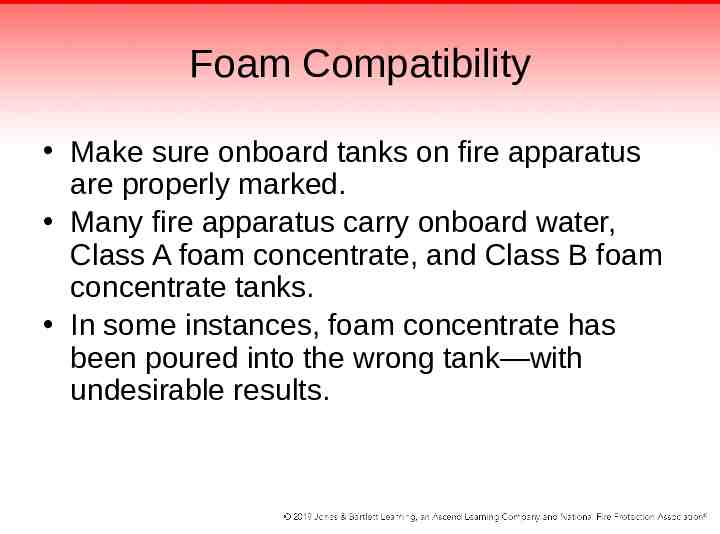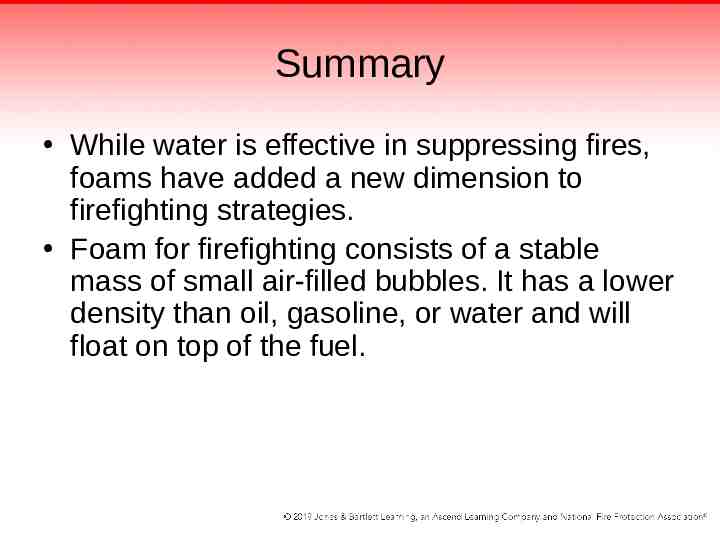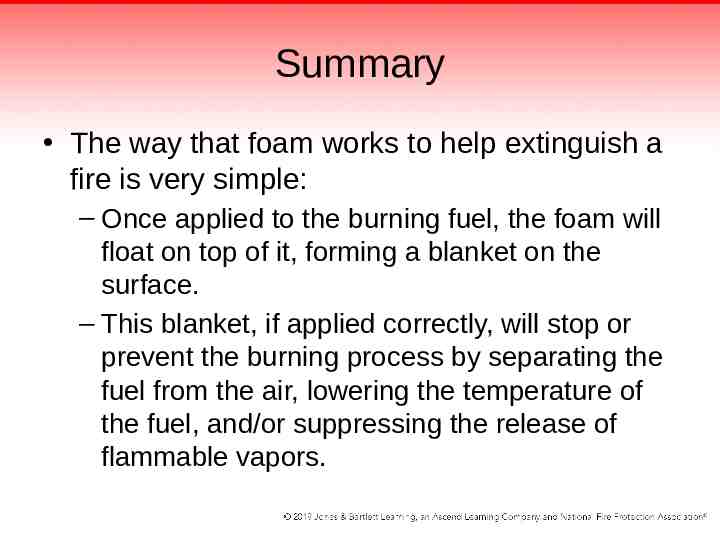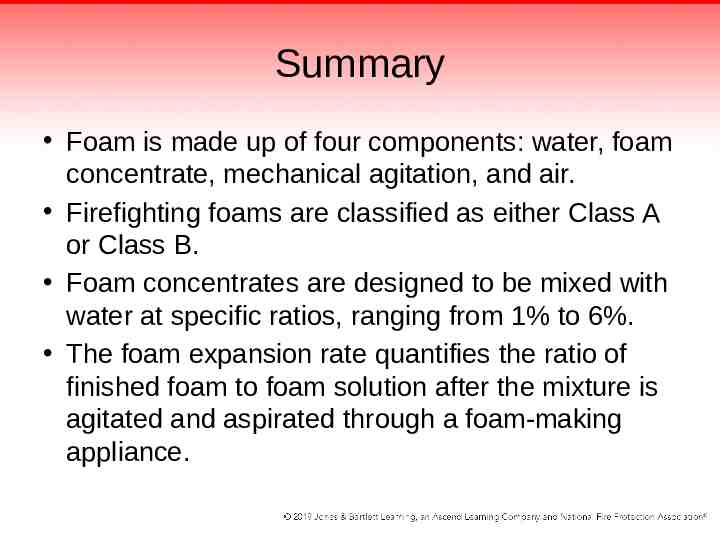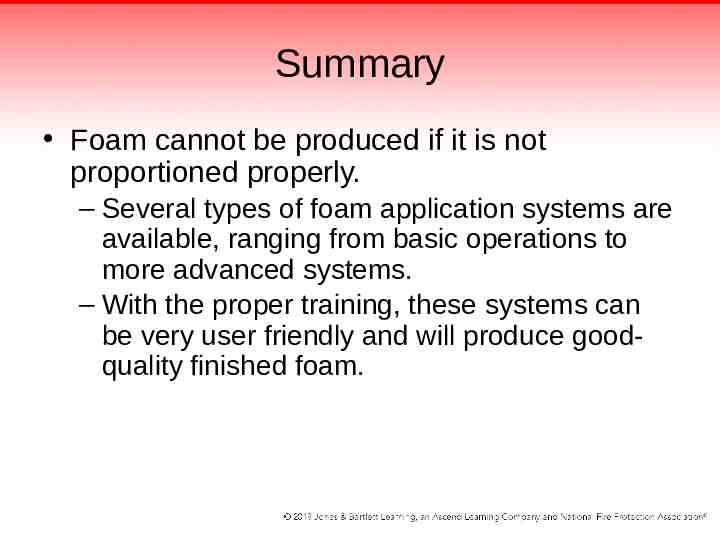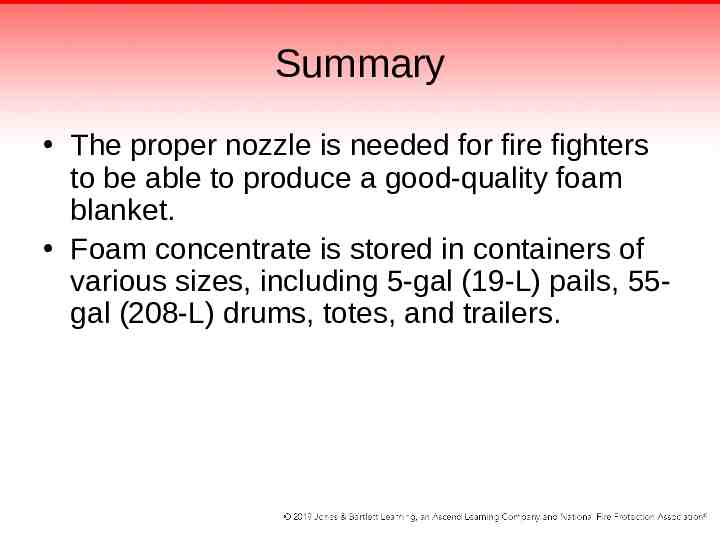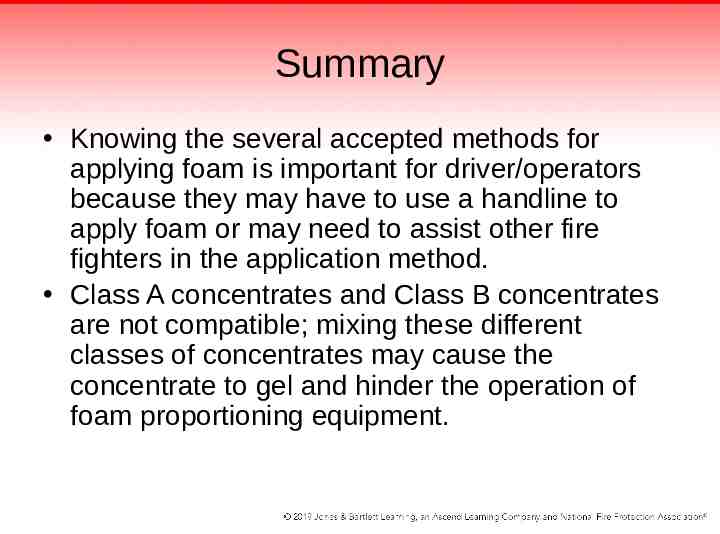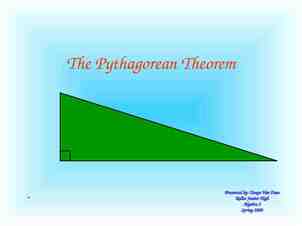Chapter 14: Foam
97 Slides4.81 MB
Chapter 14: Foam
Knowledge Objectives Describe how foam works. Describe the foam tetrahedron. Describe foam characteristics. Describe the different types of foam concentrates. Describe foam expansion rates.
Knowledge Objectives Describe foam percentages and their importance. Describe foam guidelines and limitations. Describe the different types of foam application systems.
Introduction Water has been the main means of suppressing fires for many years. – Effective, bountiful, and relatively inexpensive Foams have added a new dimension to fighting fires.
Introduction Fire fighters must contend with a wide variety of incidents involving combustible liquids and flammable liquids. Successful control and extinguishment of these incidents require not only the proper application of foam on the fuel surface, but also an understanding of the physical characteristics of foam.
Introduction A full understanding of foam and its application is imperative to a safe and successful suppression operation. Improvements in application techniques and the versatility of foam concentrates make the use of foam for all types of fires more common. – NIST has determined that foam is three to five times more effective than plain water.
History Foam has been available for firefighting for many years. – Introduced as an extinguishing agent for flammable liquid fires in the 1800s – Foam was produced by mixing aluminum sulfate and sodium bicarbonate with water in a foam generator. – To operate the fire extinguisher, a seal was broken and the extinguisher was inverted, allowing the aluminum sulfate and sodium bicarbonate to mix and create the foam.
History In the 1940s, a foam concentrate based on liquid protein was introduced. – Made from natural animal protein byproducts – Used to fight flammable liquid fires aboard Navy ships Bortel Pavel/Shutterstock, Inc.
History In the 1960s, fluoroprotein foam (FP) and aqueous film-forming foam (AFFF) were introduced. – These foams were more versatile and performed better than protein foam. – In particular, they were able to knock down fires faster than protein foam and had a longer blanket life.
History In the 1970s, alcohol-resistant foams became available. – Could be used for fires involving hydrocarbon or polar solvent fuels – Introduction of these foams allowed flexibility in dealing with the many types of fuels that fire fighters encounter on a daily basis.
History Technological improvements made to foams and equipment have made their use more common and acceptable in today’s fire service. – Operation and maintenance of these systems have emerged as important skills for the driver/operator.
Overview Water is not effective for extinguishing fires involving petroleum products. – Heavier than petroleum – Could actually spread the fire Firefighting foam was one method used to deal with petroleum products.
Overview What is foam? – Stable mass of small, air-filled bubbles – Has a lower density than oil, gasoline, or water, meaning that it will float on top of the fuel
Overview Jones & Bartlett Learning.
Overview Foam is created through the application of four components. – Water, foam concentrate, mechanical agitation, and air The ratio of water to foam concentrate is critical. Expansion of foam solution depends on good mechanical agitation and effective aeration. – When insufficient amount air is introduced into the solution stream, the solution is poorly aerated. – Results in less effective foam
Foam Tetrahedron Depicts the elements needed to produce finished foam Any element missing or not at proper mixture affects the foam production Jones & Bartlett Learning.
Chemical foam is produced through a reaction between two chemicals. Mechanical foam is produced when water is mixed with a foam concentrate in appropriate amounts. Lksstock/Dreamstime.com. Foam Tetrahedron
Foam Characteristics Foam must have good knockdown speed and flow as well as good fuel resistance. – Must have good heat resistance so it can avoid breakdown from the effects of direct flame contact with burning fuel vapors or the heat generated from metal objects
Foam Characteristics Ideally, foam will produce a good vapor-suppressing blanket. Jones & Bartlett Learning. Photographed by Glen E. Ellman.
Class A Foams Used on ordinary combustible materials (wood, textiles, paper) Effective on organic materials (straw, hay) Sometimes referred to as wetting agents Effective because they improve the penetrating effect of water and allow greater heat absorption
Class A Foams Jones & Bartlett Learning. Photographed by Glen E. Ellman. Extinguish fire in Class A materials as much as 20 times faster than water
Class A Foams Particularly useful for protecting buildings in rural areas during forest or brush fires with limited water supply Used as an obstruction to the spread of fire Jones & Bartlett Learning. Photographed by Glen E. Ellman.
Class A Foams Used by many departments while performing initial fire attack and overhaul Increase effectiveness of water as an extinguishing agent by reducing water’s surface tension Can be added to water streams and applied with various nozzles
Class B Foams Used on hydrocarbon, combustible fuels, or polar solvent fires Divided into three categories – Protein foams – Fluoroprotein foams – Alcohol-resistant film-forming fluoroprotein foam (AR-FFFP)
Wetting Agents and Foams Very different in chemical make-up Wetting agents reduce surface tension of water and enhance penetration into burning fuel. Foam creates a stable mass of small, air-filled bubbles with lower density than oil, gas, or water and will float on top of the burning fuel, creating a blanket that separates the fuel from air, lowering the temperature and suppressing the vapors.
Wetting Agents and Foams Make sure the foam or wetting agent is listed by a national recognized listing agency. Over the past 35 years, there have been significant scientific advancements for both wetting agents and foams. – Ensure that the product is listed by an independent testing firm and meets the current NFPA standards.
Protein Foams Used to extinguish Class B fires involving hydrocarbons Contain animal by-products as foaming agent Include stabilizers and inhibitors, which prevent corrosion and control viscosity May be created using either fresh or salt water
Protein Foams Regular protein foams have slower knockdown characteristics than other concentrates but provide a longlasting foam blanket after the fire is extinguished. Jones & Bartlett Learning. Photographed by Glen E. Ellman.
Fluoroprotein Foams Consist of hydrolyzed protein, stabilizers, preservatives, and synthetic fluorocarbon surfactants Intended for use on hydrocarbon fuels and some oxygenated fuel additives May be created using either fresh or salt water
Fluoroprotein Foams These foams should not be used with nonaspirating structural fog nozzles. Film-forming fluoroprotein foam (FFFP) includes protein and fluorochemical surfactants. Jones & Bartlett Learning.
Alcohol-Resistant Film-Forming Fluoroprotein Foams Can be used on both hydrocarbon and water-soluble fuels AR-FFFP is basically FFFP with a polysaccharide polymer additive. Polymer in AR-FFFP forms a membrane to separate the polar solvent from the foam blanket.
Synthetic Foams Aqueous Film-Forming Foam (AFFF) – Based on combinations of fluorochemical surfactants, hydrocarbon surfactants, and solvents – Used by the majority of municipal and airport fire departments in North America – Very fluid and quickly flows around obstacles and across the fuel surface
Synthetic Foams AFFF (cont’d) – Consists of a mixture of synthetic foaming agents and fluorochemical surfactants – Use aspirating foam nozzles to apply AFFF to ensure maximum performance. Jones & Bartlett Learning.
Alcohol-Resistant Aqueous Film-Forming Foams Combination of synthetic detergents, fluorochemicals, and high-molecular-weight polymers Neither polar solvents nor water-miscible fuels are compatible with non-alcohol-resistant foams. When non-alcohol-resistant foam is applied to the surface of a polar solvent, the foam blanket quickly breaks down into a liquid and mixes with the fuel.
Alcohol-Resistant Aqueous Film-Forming Foams Jones & Bartlett Learning. Photographed by Glen E. Ellman. Acts like a conventional AFFF on hydrocarbon fuels When applied to polar solvents, forms a polymeric membrane on the fuel surface. Membrane separates the fuel from foam and prevents destruction of the blanket. One of the most versatile types of foam
Synthetic Detergent Foams (HighExpansion Foams) Highly effective in confined-space firefighting operations and areas with limited access or dangerous entry Can be used on either Class A or Class B fires Jones & Bartlett Learning. Photographed by Glen E. Ellman.
Synthetic Detergent Foams (HighExpansion Foams) Fire control and extinguishment are achieved by rapid smothering and cooling of the fire. Tremendous smothering and steam generation effect because water contained in foam is divided into fine particles, which enhances the heat absorption – Also presents a potential hazard
Foam Concentrates Foam concentrates are designed to be mixed with water at specific ratios.
Foam Concentrates Ratios vary from 0.1% to 1% for Class A foams and from 1% to 6% for Class B foam. Amount of concentrate varies depending on the manufacturer, the type of application, and the type of fuel.
Foam Concentrates Foam concentrate must be proportioned at the percentage listed by its manufacturer. – Each foam is tested and approved for certain types of fires and at specific ratios. – Manufactured at different percentages – Components include the concentrate plus any freeze protection additives. – Military-use specifications and cost are some of the basic factors that determine the percentage of concentrate used in any particular situation.
Foam Concentrates Current trend is to keep foam concentrate percentages as low as possible. Lower proportioning rates mean: – Less bulk in storage for fire departments – Ability to double firefighting capacity by carrying the same volume of foam concentrate – Reduced cost of fixed foam system components and transportation cost
Foam Concentrates Alcohol-resistant foams can be used on both hydrocarbon and polar solvent fuels. – Commonly used concentrate for this purpose – AR-AFFF concentrate is available as: 3%/3% product mix 3%/6% mix 1%/3% mix
Foam Concentrates The selection of the right concentrate is critical to the safe and effective handling of an incident. – Knowledge of the foam types and systems available will assist incident commanders in their ability to mitigate an incident. – Importance of preplanning and training for these types of incidents cannot be stressed strongly enough.
Foam Expansion Rates Foam expansion rate is the ratio of finished foam to foam solution after the concentrate is mixed with water, agitated, and aspirated through a foam-making appliance. – The air inside the bubbles makes up the expanded part of the finished foam.
Low-Expansion Foam Foam expansion ratio of up to 20:1 Primarily designed for use on flammable and combustible liquids Effective in controlling and extinguishing most Class B fires Special low-expansion foams are also used on Class A fires where the penetrating and cooling effect of the foam solution is important.
Medium-Expansion Foam Foam expansion ratio in the range of 20:1 to 200:1 Used primarily to suppress vapors from hazardous chemicals Foams with expansion ratios between 30:1 and 55:1 have been found to produce the optimal foam blanket for highly reactive chemicals and low-boiling-point organics.
High-Expansion Foam Foam expansion ratio in the range of 200:1 to 1000:1 Designed for confined space firefighting Foam concentrate consists of a synthetic, detergent-type foam used in confined spaces such as basements, mines, shipboard, and aircraft hangars
Proportioning Foam Concentrate Application of foams at the proper percentage depends on the foam concentrate being mixed at the proper percentage with water. As the driver/operator, you have the responsibility to produce effective foam streams. To produce finished foam, the water, air, and foam concentrate must be mixed at the proper ratio.
Foam Proportioning Systems Foam proportioner is the device that mixes the foam concentrate into the fire stream in the proper percentage. Eductors and injectors are available in a wide range of sizes and capabilities. Foam solution can also be produced by batch mixing or premixing.
Batch Mixing Jones & Bartlett Learning. Photographed by Glen E. Ellman. Process of pouring foam concentrate directly into the fire apparatus water tank and mixing a large amount of foam at one time
Batch Mixing Proper amount of foam concentrate must be poured into the onboard tank to produce the desired percentage in the finished foam. Some problems may arise with batch mixing: – Foam solution is corrosive to the apparatus’ pipes, pump, and water tank. – Difficult to adjust and maintain the correct application rate. – Addition of foam solution may cause the gauges to become inaccurate.
Batch Mixing Class A foam concentrates that are batch mixed must be used within 24 hours if they are to be effective. When the water tank is empty, there is no longer any foam available—a new batch has to be mixed. If you know the amount of water in the onboard water tank, simply add the foam concentrate to achieve the desired foam solution percentage.
Premixing Technique is usually reserved for portable fire extinguishers. Product is quick and easy to deploy but contains a limited amount of foam and should be applied only to small fires or fuel spills. Always refer to the foam manufacturer’s recommendations for how long foam concentrate should be used after mixing it with water.
Foam Eductors Induction involves the use of an eductor to introduce the appropriate amount of foam concentrate into a stream of water. Eductor is an appliance that uses the Venturi principle to introduce foam concentrate into the water stream. – Eductor can be built into the plumbing of an engine, or a portable eductor can be inserted in an attack hoseline.
Foam Eductors Usually designed to work at a predetermined pressure and flow rate Two types are used in the fire service: – In-line eductors have long been used to proportion foam. – Bypass eductors are permanently mounted appliances that can be used for water or foam application.
Foam Eductors – May be mounted permanently on the apparatus – May be portable and connected anywhere along the hose lay Jones & Bartlett Learning. Photographed by Glen E. Ellman. In-line eductors are very simple to operate and are found in many fire departments.
Foam Eductors Eductors use the Venturi principle to mix a specific amount of foam concentrate into the water stream. – Foam concentrate is introduced into the eductor using a metering valve. This allows the driver/operator to adjust the percentage of foam concentrate being added to the water stream.
Metering Device Controls the flow of concentrate into the eductor Have adjustable settings that range from 0 (the closed position) to 6 percent Jones & Bartlett Learning. Photographed by Glen E. Ellman.
Metering Device Percentage set on the metering valve will be achieved only if the inlet pressure at the eductor matches the manufacturer’s recommended inlet pressure. A higher inlet pressure at the eductor will cause the foam solution to have a lower percentage of concentrate.
Operating the In-Line Eductor In-line eductor is attached to the hoseline no more than 150 ft (45 m) from the nozzle and no more than 6 ft (2 m) above the surface of the foam concentrate. Although this type of device is simple to operate, some very specific instructions must be followed to ensure its proper use.
Around-the-Pump Proportioning System Operates on the same principle as the in-line or bypass eductor system Offers several advantages: – Process used for engaging the pump is the same for water or foam operations. – Variable flow discharge rate allows for adjustment of the foam depending on the specific application. – Variable pressure operations are possible. – No backpressure or nozzle restrictions
Around-the-Pump Proportioning System Limitations: – All discharges will have either foam or water available at the same time. – Will not be able to supply some lines with water and other lines with foam simultaneously Maximum inlet pressure to the water pump cannot be more than 10 psi (70 kPa).
Around-the-Pump Proportioning System AP systems are intended to operate with water supplied from the onboard tank or from draft. – Use of a pressurized source (hydrant or relay) will affect the operation of the system. All discharges must be flushed after the foam operation has ended, even if they were not used.
Balanced-Pressure Proportioning Systems Extremely versatile and accurate means to deliver foam Uses a diaphragm-type pressure control valve to sense and balance the pressures in the foam concentrate and water lines to the proportioner Used with permission of Tyco Fire Protection Products.
Balanced-Pressure Proportioning Systems Foam concentrate pump is a separate pump that supplies foam concentrate to the pressure control valve and ratio controller. Ratio controller is required for each foam outlet to proportion the correct amount of foam concentrate. Metering valves receive foam concentrate from the foam pump and discharge the concentrate to the individual ratio controllers.
Balanced-Pressure Proportioning Systems Duplex gauge at the pump panel allows the driver/operator to monitor the foam concentrate and water pressures. Jones & Bartlett Learning. Photographed by Glen E. Ellman.
Injection Systems Use an electrically operated, variable-speed foam concentrate pump that directly injects foam concentrate into the discharge side of the pump manifold Depend on the water flow for their operation Unaffected by changes in suction and discharge pressure
Injection Systems Direct-injection systems are very user friendly. With injection systems, the driver/operator can adjust the foam concentrate percentage while the system is in operation. Injection foam systems can be used with standard nozzles, aspirating nozzles, and a compressed-air foam system.
Compressed-Air Foam Systems Combines compressed air and a foam solution to create the finished foam – Designed for a quick and effective fire attack and exposure protection – Used to create a highquality finished foam that clings to vertical surfaces Dale A. Stork/ShutterStock, Inc.
Compressed-Air Foam Systems Foam holds moisture on the fuel’s surface, where it either evaporates or penetrates, cooling and lowering the fuel’s temperature. Production of finished foam depends on the correct mixture of water, foam concentrate, and air within the CAFS. – System produces high-quality finished-foam streams inside the fire apparatus piping.
Compressed-Air Foam Systems Key benefits: – Foam quality is greatly improved. – Foam works 4-5x faster than water. – Less water is used, reducing water damage. – Quick knockdown, fast fire suppression, and less extensive water damage may help fire investigators determine the cause of the fire. – Reach of fire stream is improved.
Compressed-Air Foam Systems Key benefits (cont’d): – Weight of the attack line is less than that of containing just water. – Because the hose is filled with air, friction loss is insignificant. – There is not the normal pressure loss with elevation.
Compressed-Air Foam Systems Problems related to CAFS: – Driver/operator needs to know about air compressor operation. – Water and air are incompressible, so the foam solution has to be in the water stream before injecting the compressed air. – Burst hose lines react more erratically due to the air in the line. – Nozzle reaction is greater, so nozzles should be opened slowly.
Nozzles Nozzles are an important part of all foam operations. The proper nozzle is needed for fire fighters to be able to produce a good quality foam blanket.
Medium- and High-Expansion Foam Generators Usually consist of either a mechanical blower or a water-aspirating appliance Water-powered aspirating generator uses a water-motor-driven fan to produce the required air flow.
Medium- and High-Expansion Foam Generators Mechanical generators operate similarly to water-aspirating generator. High-expansion foams produce large volumes of foam that exclude oxygen from the incident area. Courtesy of Roy Robichaux, ConocoPhillips Alliance Refinery.
Master Stream Foam Nozzles Allow operators to deal with large incidents where handline nozzles are not able to handle the demands for foam suppression Can be supplied from the fire apparatus’ onboard systems (injection) A pick-up tube draws the foam into the master stream nozzle. Can be mounted permanently on the fire apparatus, can be removable so that they can be used as a portable unit, or can be strictly portable devices
Air-Aspirating Foam Nozzles Designed to mix air with the foam solution as it is discharged Effect is achieved without having to add a clamp-on tube to a fog nozzle. These nozzles are designed to aspirate the foam solution to produce good-quality finished foam.
Smooth-Bore Nozzles The nozzle of choice when using a CAFS Because the aeration of the foam solution takes place in the piping and hose, the finished foam will be discharged at the nozzle. Application is the major concern when a smooth-bore nozzle is used with a CAFS. – Not aeration
Fog Nozzles Can be used to produce finished foam When the incident involves polar solvent fuels, fog nozzles may not deliver a foam quality that is able to extinguish the fire. Foam aeration tubes are available that can be easily and quickly clamped onto the end of a fog nozzle to aerate the foam solution more efficiently.
Foam Supplies Foam concentrate is stored in containers that range in size from 5-gal pails to 55-gal drums. Jones & Bartlett Learning. Photographed by Glen E. Ellman.
Foam Supplies Totes and trailers of foam concentrate are available in different sizes as well, ranging from 100 to 1000 gal of foam concentrate. Foam may be stored in its container without any change in its original physical or chemical characteristics. Freezing and thawing usually will not have any effect on modern foam concentrates.
Foam Supplies The shelf life of foam concentrate will vary depending on the type of concentrate. – Typically, protein concentrate has a shelf life in the range of 7 to 10 years. – Synthetic concentrates and high-expansion concentrates have a shelf life of 20 to 25 years.
Foam Supplies The environmental impact of foam use has been a concern for many years. – Many types of foam have undergone testing to assess their effects on the environment. – Information regarding toxicity of foam concentrates is usually available from product environmental data sheets, material safety data sheets, product technical bulletins, and toxicity summary sheets.
Foam Application: Class A Use of Class A foam for structural firefighting is becoming a more common practice. Use of Class A foam for firefighting is similar to the use of water. Training and experimentation with Class A foam in actual fire situations is not recommended due to safety concerns.
Foam Application: Class B Directing a Class B foam stream into a Class B fire can disrupt the fuel and cause the fire to spread. Plunging the stream into an existing foam blanket will allow vapors to escape. Three methods used: – Roll-on method, bankdown method, and raindown method
Foam Application: Sweep (Roll-on) Method Use only on a pool of flammable product on open ground. Direct the foam stream onto the ground in front of the product involved. If needed, move the hose line or use multiple lines to cover the material. If multiple lines are used, be aware of other fire fighters in the area.
Foam Application: Bankshot (Bankdown) Method Fire fighter uses an object to deflect the foam stream so it flows down the burning surface. Application should be as gentle as possible. Direct the foam at a vertical object. Allow the foam to spread over the material and form a foam blanket.
Foam Application: Raindown Method Used when you cannot employ the bankshot method or the roll-on method Loft the foam stream into the air above the material and let it fall gently onto the surface. Effective as long as the foam stream completely covers the material Might not be effective if wind conditions are unfavorable
Foam Compatibility Class A concentrates and Class B concentrates are not compatible. Mixing them may cause the concentrate to gel and hinder the operation of foam proportioning equipment. Class B foam concentrates may not be compatible with each other. Check with the foam manufacturer for information on compatibility of particular types of foam.
Foam Compatibility Make sure onboard tanks on fire apparatus are properly marked. Many fire apparatus carry onboard water, Class A foam concentrate, and Class B foam concentrate tanks. In some instances, foam concentrate has been poured into the wrong tank—with undesirable results.
Summary While water is effective in suppressing fires, foams have added a new dimension to firefighting strategies. Foam for firefighting consists of a stable mass of small air-filled bubbles. It has a lower density than oil, gasoline, or water and will float on top of the fuel.
Summary The way that foam works to help extinguish a fire is very simple: – Once applied to the burning fuel, the foam will float on top of it, forming a blanket on the surface. – This blanket, if applied correctly, will stop or prevent the burning process by separating the fuel from the air, lowering the temperature of the fuel, and/or suppressing the release of flammable vapors.
Summary Foam is made up of four components: water, foam concentrate, mechanical agitation, and air. Firefighting foams are classified as either Class A or Class B. Foam concentrates are designed to be mixed with water at specific ratios, ranging from 1% to 6%. The foam expansion rate quantifies the ratio of finished foam to foam solution after the mixture is agitated and aspirated through a foam-making appliance.
Summary Foam cannot be produced if it is not proportioned properly. – Several types of foam application systems are available, ranging from basic operations to more advanced systems. – With the proper training, these systems can be very user friendly and will produce goodquality finished foam.
Summary The proper nozzle is needed for fire fighters to be able to produce a good-quality foam blanket. Foam concentrate is stored in containers of various sizes, including 5-gal (19-L) pails, 55gal (208-L) drums, totes, and trailers.
Summary Knowing the several accepted methods for applying foam is important for driver/operators because they may have to use a handline to apply foam or may need to assist other fire fighters in the application method. Class A concentrates and Class B concentrates are not compatible; mixing these different classes of concentrates may cause the concentrate to gel and hinder the operation of foam proportioning equipment.


























































































